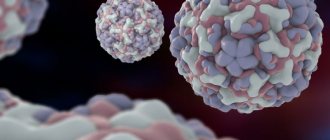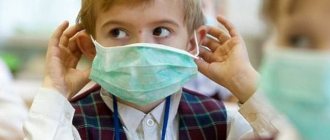Tetanus - symptoms in humans, photos, signs, treatment
Tetanus is an acute bacterial disease that causes severe damage to the nervous system with the development of tonic tension of skeletal muscles and generalized convulsions.
Most people know that tetanus is extremely dangerous and very often leads to painful death.
What kind of disease is this? What symptoms does it manifest? Why is death a common outcome? How can you protect yourself? What to do if infection does occur? More details in our article.
Tetanus disease
Tetanus belongs to the group of neuroinfections. This disease can affect not only humans, but also all warm-blooded animals. Most often, signs of tetanus are found in residents of rural areas. This is due to the fact that the infectious agent can remain in the soil for a long time.
The disease is not transmitted through ordinary contact with a carrier of the bacterium. In order for a person to become infected, the pathogen must come into contact with the wound surface.
It is not the microorganism itself that is dangerous to humans, but its metabolic products, because they contain a powerful biological poison that affects the nervous system: first the peripheral and then the central. The toxin is safe if swallowed, as it is not able to be absorbed through the mucous membrane. It is destroyed when:
- exposure to an alkaline environment,
- sunlight
- when heated.
Causes
Tetanus is caused by Clostridium tetani spores entering a wound. In the absence of oxygen, they transform into active forms. The bacterium itself is harmless. But it produces the strongest biological poison - tetanus toxin, which is second only to botulinum toxin in its toxic effect.
Routes of infection with tetanus:
- puncture, cut or laceration wounds;
- splinters, skin abrasions;
- burns/frostbite;
- fractures and animal bites;
- umbilical wound in newborns.
People who need frequent injections are also at greater risk. Any wound (including bites and burns) increases the risk of contracting tetanus.
The most common causes of death from tetanus are:
- suffocation as a result of prolonged spasm of the ligaments or respiratory muscles;
- heart failure;
- spine fracture;
- pain shock.
In children, tetanus is complicated by pneumonia, and at a later date by indigestion and anemia.
The disease tetanus develops exclusively when the microorganism gets on the wound surface.
Incubation period
- The incubation period of the disease can last from several days to one month, on average from 7 to 14 days.
- The shorter the incubation period, the more severe the disease and the higher the likelihood of death.
- The farther the lesion is located from the central nervous system, the longer the IP. With a short incubation period, the disease is more severe. Short IP is observed with injuries to the neck, head and face.
Symptoms of tetanus in humans and photos
There are 4 periods during the disease:
- Incubation.
- Start.
- The height of
- Recovery.
In the photo the man has tetanus
On average, the incubation period lasts about 2 weeks. The start time for this classification is 2 days. During this period, the main symptoms of tetanus are: pain at the site of penetration of clostridia. The wound in this place, as a rule, has already healed. Then trismus appears - a spasm of the masticatory muscles. The jaws are clenched convulsively, so that not all patients can open their mouths.
During the height of the disease, symptoms of skeletal muscle irritation appear. Muscle hypertonicity is accompanied by severe pain. Extensor reflexes predominate, which is manifested by stiffness of the neck muscles, throwing the head back, hyperextension of the spine (opisthonus), and straightening of the limbs. Hypertonicity of the muscles involved in breathing leads to hypoxia.
Symptoms of tetanus in humans:
- spasm of the masticatory muscles (difficulty opening the mouth);
- spasms of the facial muscles (a “sardonic” smile appears, the lips are stretched, their corners are lowered, the forehead is wrinkled);
- Due to spasm of the pharyngeal muscles, swallowing is impaired;
- convulsions that cover all the muscles of the body in a downward direction (a person arches, standing on his heels and the back of his head - opisthotonus). Painful cramps occur even with minor irritation;
- seizures occur in response to any irritating factor (light, sound, noise).
At an early stage, tetanus has symptoms similar to many diseases, for example, gingivitis and inflammation of the mandibular joints. Indeed, during the development of tetanus bacillus in the body, the masticatory muscles are in constant tension and sometimes twitch. Gradually, the infection begins to resemble epilepsy and a severe hysterical attack.
The action of the pathogen, as we have already noted, occurs extremely quickly; moreover, the first symptoms of tetanus in humans are observed within a few hours from the moment it enters the body.
The waste products of infection are not absorbed through the mucous membrane, which determines their absolute safety when swallowed; in addition, exposure to ultraviolet radiation and heating leads to a very rapid death of pathogens.
It is worth noting that the most dangerous period of tetanus is considered to be from the 10th to the 14th day of the disease. It is at this time that the patient experiences rapid metabolism, metabolic acidosis and increased sweating. A cough begins and it is sometimes very difficult for the patient to clear his throat. In addition to all this, convulsive attacks may occur during coughing and swallowing.
The first signs of tetanus in adults
Adults have immunity against infection due to vaccination. To maintain the required concentration of protective antibodies in the blood, revaccination is required every 10 years. In the absence of natural protection, adults, like children, develop acute symptoms:
- its earliest sign may appear - dull nagging pain in the area where the infection has penetrated through the damaged skin;
- tension and convulsive contraction of the masticatory muscles, which leads to difficulty opening the mouth;
- difficult and painful swallowing caused by convulsive spasm of the pharyngeal muscles.
How does the disease progress in children?
Infection of newborns with tetanus occurs mainly during childbirth outside a medical institution, when they are delivered by people who do not have a medical education, in unsanitary conditions, and the umbilical cord is tied with unsterile objects (cut with dirty scissors, a knife, and tied with ordinary untreated threads). The incubation period is short, 3-8 days, in all cases a generalized severe or very severe form develops.
Tetanus most often occurs in children between the ages of three and seven years. Mostly this disease has a summer seasonality and affects rural residents more.
There are certain symptoms that appear when tetanus is fully developed. The child has:
- the muscles of the legs, arms and torso are under severe tension;
- they do not relax even during sleep;
- the contours of the muscles begin to emerge, especially in boys;
- after three to four days, the muscles of the abdominal wall harden, the lower limbs spend a large amount of time in an extended position, and their movement is limited;
- breathing becomes interrupted and quickens;
- swallowing becomes difficult, causing pain when breathing.
If parents promptly show medical workers a child who has tetanus, treatment occurs gradually and the symptoms of this disease disappear over time. The duration of this stage reaches 2 months.
Throughout this period, the child is at high risk of developing a variety of complications. In this regard, constant monitoring of its condition is required.
Stages of the disease
As with any infectious process, the clinical picture of tetanus consists of several successive periods. The following stages of disease development are distinguished:
| Stages of tetanus | Description and symptoms |
| Lightweight | Last no more than 21 days. Characterized by moderate spasms of the facial and back muscles. Clonic-tonic convulsions may be completely absent. The temperature may remain within normal limits or be slightly elevated. |
| Average | The moderate degree of the disease manifests itself in the progression of muscle damage with typical signs, tachycardia and a strong increase in body temperature. The frequency of seizures is no more than one to two times per hour, and their duration is no more than half a minute. |
| Heavy | Symptoms: convulsions are frequent and quite intense, a characteristic facial expression appears. |
| Extremely heavy | A particularly severe course is encephalitic tetanus (Brunner) with damage to the medulla oblongata and upper parts of the spinal cord (cardiovascular, respiratory centers), neonatal tetanus and gynecological tetanus. |
Possible complications
The prognosis of tetanus depends on the form of the course, which is more severe the shorter the incubation period and the faster the development of clinical symptoms. Severe and fulminant forms of tetanus are characterized by an unfavorable prognosis; if timely assistance is not provided, death is possible. Mild forms of tetanus can be successfully treated with proper therapy.
Any serious illness leaves its traces and tetanus is no exception. Because of this, the following complications arise:
- Sepsis;
- Ruptures of muscle tissue and ligaments;
- Fractures;
- Inflammation of the lungs and bronchus.
Diagnostics
Tetanus is a serious infection that can be prevented by vaccination. If the disease does occur, early diagnosis is necessary. The earlier this disease is suspected, the greater the chance of survival the patient has.
Of the laboratory methods, bacteriological diagnostics is acceptable and most relevant, since it is aimed at isolating and identifying the pathogen and detecting its toxin in the test material (microscopy of fingerprint smears, histological examination of tissues).
Treatment of tetanus in humans
Treatment of tetanus should only be carried out in a hospital setting. The main goal is to neutralize and remove the toxin from the body as quickly as possible.
The wound through which the infection occurred is injected with anti-tetanus serum, then it is opened wide and a thorough surgical treatment is carried out. The faster treatment with anti-tetanus serum is carried out, the easier the symptoms of tetanus are tolerated and the fewer consequences the disease has for the body.
Subsequently, preparations containing proteolytic enzymes (Chymotrypsin, Trypsin, etc.) are usually used to heal the wound.
The course of treatment for tetanus includes:
- combating tetanus pathogens in the area of the primary lesion (opening the wound, removing dead skin, sanitation and aeration);
- administration of antitetanus serum; relief of severe cramps;
- maintaining the vital functions of all body systems;
- prevention of complications;
- complete nutrition, rich in vitamins and microelements to strengthen the immune system.
It is desirable that the patient be treated in a separate room, which will eliminate the negative impact of emerging external stimuli on him.
In addition, it is important to have a permanent post for systematic monitoring of the patient’s general condition. If it is not possible to take food on your own, it is administered through the use of a probe.
If a person has had tetanus, he does not develop long-term immunity, and he can become infected with this disease again.
Prevention
Prevention of tetanus can be:
- nonspecific: prevention of injuries, contamination of wounds, sanitary education, thorough surgical treatment with timely dressings, compliance with the rules of asepsis and antisepsis in hospitals;
- specific: vaccination.
Source: https://www.zdoroviyvopros.ru/infektsionnye-zabolevaniya/stolbnyak-u-cheloveka/
Warnings
- Thanks to widespread immunization, tetanus is now quite rare. However, if the disease is neglected, the consequences can be very serious. If you think you have contracted tetanus, contact your doctor immediately.
Tetanus is widespread throughout the world and is especially common in hot climates. The source of infection is animals; the pathogen is transmitted through the soil. Tetanus is considered an occupational disease of diggers and farmers.
, since it enters the human body through damaged skin or mucous membranes. In peacetime, isolated cases of the disease are recorded in developed countries, while during military operations and in regions with poor social and living conditions, epidemics are possible.
Due to its high mortality rate, tetanus is a dangerous infectious disease. In countries where preventive vaccinations are not carried out and there is no opportunity to provide qualified assistance, eight out of 10 patients die. This infectious disease is especially severe in newborns, who can become infected through the umbilical cord.
What kind of disease is tetanus
Tetanus has been known since the time of Hippocrates, who was the first to make a detailed description of this disease. In ancient times, tetanus was common in men during wars. And for women - after childbirth or abortion. At that time, the nature of tetanus was not yet known. The fact that this disease is caused by a bacterium was discovered only at the end of the 19th century.
Tetanus still scares people today. After all, most people know that it is extremely dangerous and very often leads to painful death. What kind of disease is this? What symptoms does it manifest? Why is death a common outcome? How can you protect yourself? What to do if infection does occur?
The causative agent of tetanus
What is tetanus? is a severe infectious disease in which the nervous system is affected and multiple severe convulsions occur, often leading to death.
The causative agent of tetanus is Clostridium tetani. It belongs to bacteria that live in an airless environment; oxygen has a detrimental effect on it. However, this microorganism is very stable due to its ability to form spores.
Spores are resistant forms of bacteria that can survive in unfavorable environmental conditions. In the form of spores, Clostridium tetani easily tolerates drying, freezing and even boiling.
And when exposed to favorable conditions, for example, a deep wound, the spore becomes active.
Clostridium tetani spores are found in soil, house dust, feces of many animals, and natural bodies of water.
If this spore is so common in our environment, then the question arises, why do not all people become infected with tetanus? The fact is that this microbe is safe if swallowed. Although it is not destroyed by hydrochloric acid and enzymes, it cannot be absorbed through the gastrointestinal tract.
How is tetanus transmitted? This is a wound infection - the pathogen can enter the body through wounds, burn surfaces, and frostbite areas. Clostridium tetani loves deep wounds, as they can create oxygen-free conditions.
Where is the disease common?
Tetanus is distributed throughout the globe. Large concentrations of the pathogen in the soil have been observed in areas with a humid and warm climate. The incidence worldwide is about 1 million people per year.
Do people die from tetanus? In terms of mortality, the disease is in second place after rabies among all infectious diseases. Its mortality rate, depending on the area, ranges from 40 to 70%.
More than 60,000 people die from this disease every year. These statistics do not include unexpressed forms of the disease and unreported cases.
In developed countries where tetanus vaccination is mandatory, the mortality rate is 0.1–0.6 per 100,000 population, and in developing countries it is up to 60 per 100,000.
Among children, 80% of cases of the disease occur in newborns, mainly in poor countries (Africa, Latin America, Asia). Among the adult population, 60% are elderly. In rural areas, mortality is higher than in urban areas due to high injury rates.
Routes of infection
How can you get tetanus? This is a zooanthroponotic disease, that is, characteristic of both animals and humans. But one person cannot infect another. You can get tetanus if you have a deep wound. The following are susceptible to this disease:
- children under the age of 8–9 years due to the high level of traumatization (especially boys);
- newborns as a result of violation of the rules of asepsis and antisepsis when cutting the umbilical cord;
- adults with deep wounds (especially feet, palms, face).
The source of infection is humans and animals. The Clostridium tetani bacillus is a normal inhabitant of the intestine, does not cause harm to the host, lives, reproduces and is released as spores into the environment with feces.
You can notice the seasonality of the disease. Outbreaks are observed from April to October, during the period of active agricultural work. In 60% of cases, tetanus infection occurs when the feet are wounded. Walking barefoot, puncture wounds from nails, plant thorns, and splinters often lead to the development of tetanus. No wonder it is called “bare foot disease.”
The mechanism of origin and development of tetanus
Tetanus is caused by Clostridium tetani spores entering a wound. In the absence of oxygen, they transform into active forms. The bacterium itself is harmless. But it produces the strongest biological poison - tetanus toxin, which is second only to botulinum toxin in its toxic effect.
Tetanus toxin consists of tetanospasmin, which affects the nervous system, causing seizures, and tetanohemolysin, which causes hemolysis of red blood cells.
The toxin penetrates the nerve fibers and blood into the structures of the brain and spinal cord. There it blocks the nerve cells responsible for inhibiting muscle contractions.
Motor impulses from the brain continuously flow to the muscles, and they contract sharply and uncoordinated.
Muscle cramps last a long time, all muscles of the body are involved:
- limbs;
- spine;
- faces;
- larynx;
- hearts.
Tetanus toxin disrupts the circulation of biologically active substances in the brain, damages the respiratory center and other vital structures. Hemolytic ones fade into the background compared to neurological ones.
The first signs and symptoms of tetanus
The incubation period for tetanus from the moment the bacteria enters the wound until the first symptoms appear is 1–14 days. Its duration depends on the location of the wound, the depth of the wound, and the amount of microbe that has entered. Depending on the proximity of the wound to the face, palms or feet, the depth of penetration of the infection and its quantity depends on the speed of development of the disease.
irritability
The first signs of tetanus:
- pain in the wound area;
- headache;
- irritability.
Symptoms of tetanus in humans:
- spasm of the masticatory muscles (difficulty opening the mouth);
- spasms of the facial muscles (a “sardonic” smile appears, the lips are stretched, their corners are lowered, the forehead is wrinkled);
- convulsions that cover all the muscles of the body in a downward direction (a person arches, standing on his heels and the back of his head - opisthotonus);
- seizures occur in response to any irritating factor (light, sound, noise).
Convulsive attacks last only a few seconds or minutes, but during this time the person spends a huge amount of energy, becomes very exhausted and exhausted. As the disease progresses, the frequency of attacks increases. The condition is considered severe when they visit the patient almost continuously one after another.
During convulsions, a person does not lose consciousness, he feels severe pain throughout the body, fear, screams, and grinds his teeth. Outside of attacks, he suffers from insomnia.
How else does tetanus manifest in humans?
Difficulty opening the mouth and spasms of the throat lead to dehydration and starvation. At the same time as all the muscles, the muscles of the anus and the sphincter of the bladder also contract, so emptying is difficult. Body temperature rises to 40 °C.
sign of illness - difficulty opening your mouth
There are milder local forms of tetanus, for example, facial, when only contraction of the facial muscles is observed. But they are rare.
The tetanus clinic lasts 2–4 weeks. Recovery occurs in 1–2 months. But a person cannot start work for a long time due to stiffness of movements, compression of the vertebrae, and contractures. The prognosis in half of the cases is unfavorable. The possibility of a bad outcome may be indicated by cramps in the larynx, respiratory muscles, temperature above 41.0 °C, decreased breathing, and increased pulse.
In newborn children, tetanus is manifested by impaired sucking and swallowing, contraction of facial muscles, and a “sardonic” smile.
In premature and low birth weight babies, tetanus (an attack of seizures) may manifest itself as arching to one side. The course of the disease in newborns is particularly severe; they suffer only from general forms of tetanus.
Over the course of a day, more than 30 attacks of varying duration may occur.
Complications
In adults, the disease can be complicated by:
- muscle rupture;
- tearing of ligaments;
- bone fractures as a result of strong muscle contraction;
- bronchitis;
- pneumonia;
- sepsis.
The most common causes of death from tetanus are:
- suffocation as a result of prolonged spasm of the ligaments or respiratory muscles;
- heart failure;
- spine fracture;
- pain shock.
In children, tetanus is complicated by pneumonia, and at a later date by indigestion and anemia.
Diagnosis of the disease
Diagnosis of tetanus is based on the clinical picture of the disease. Anamnesis is of great importance. Isolation and identification of the microorganism is rarely carried out. The toxin content in the muscles is determined.
At the onset of the disease, tetanus should be distinguished from periostitis, gingivitis, abscesses of the retropharyngeal space, inflammation of the mandibular joints, when the patient cannot open his mouth. With tetanus, there is prolonged tension in the masticatory muscles and their twitching.
At a later date, tetanus should be differentiated from epileptic seizures, strychnine poisoning, and hysteria in women.
In newborns, tetanus must be distinguished from the consequences of birth trauma and meningitis. In doubtful cases, they resort to spinal puncture. In older children, tetanus should be differentiated from hysteria and rabies.
Treatment
Treatment of tetanus should only be carried out in a hospital setting. The main goal is to neutralize and remove the toxin from the body as quickly as possible.
The complex of treatment measures includes:
- treatment of an open wound, destruction of the Clostridium tetani bacillus in the wound;
- neutralization of the toxin;
- elimination of seizures;
- maintaining the functions of the heart, lungs, kidneys, brain;
- decrease in temperature when it rises;
- combating dehydration and a shift in blood pH to the acidic side;
- therapeutic and protective regime.
The patient is placed in a separate darkened room, all possible irritants are minimized. The pathogen is eliminated by surgical treatment of the wound. Neutralization of the toxin is carried out using equine tetanus serum. It is done once intramuscularly in a dose:
- adults - 100,000–150,000 IU;
- newborns—20,000–40,000 IU;
- older children - 80,000–100,000 IU.
In addition to serum, anti-tetanus human immunoglobulin is administered intramuscularly in a dose of 6 ml.
Anticonvulsants, muscle relaxants, and antipsychotics will help relieve seizures. In very severe forms, only muscle relaxants can cope with muscle contractions.
The main measures to prevent tetanus are:
- vaccination;
- injury prevention.
Active and passive prevention of tetanus is carried out routinely or urgently.
All children aged 3 months to 17 years are routinely vaccinated according to the national vaccination calendar. Vaccination, depending on the circumstances, can be done with isolated tetanus toxoid or a combined vaccine (DPT, ADS-M). For children, tetanus toxoid as part of the DTP vaccine is given:
- at 3 months;
- at 4.5 months;
- at 6 months;
- at 18 months;
- at 6–7 years old;
- at 14 years old;
- At 18 years old.
When do adults get tetanus shots? Vaccinations are given to adults every 5–10 years if desired, or to persons at risk of disease: diggers, railway workers, construction workers and others.
Vaccination of adults against tetanus, if they have not previously been vaccinated, is carried out twice, and then revaccination is done every 10 years.
If a person has had tetanus, he does not develop long-term immunity, and he can become infected with this disease again.
What vaccines are available for routine immunization? Both children and adults can be vaccinated with DPT, DPT-M, ADS-M, Pentaxim, Tetrakok, Bubo-Kok, Infanrix vaccines.
Emergency prophylaxis against tetanus is carried out in the following cases:
- for wounds and injuries contaminated with soil (especially feet, palms);
- for injuries and operations of the gastrointestinal tract;
- for frostbite and burns of II–IV degree;
- during childbirth, abortion;
- with gangrene, necrosis, ulcers on the extremities.
Emergency prevention of the disease is carried out with tetanus toxoid in a dose of 0.5 ml. If the child or adult has not been vaccinated previously, then an additional anti-tetanus serum is administered at a dose of 3 thousand IU. You can inject 3 ml of human immunoglobulin.
Tetanus vaccination during pregnancy is done only in case of strict indications. It is better to do it in advance when planning a pregnancy.
Low incidence in cities can create the impression of low prevalence and irrelevance of the disease. But that's not true. Although now is peacetime, tetanus is still a big problem. The disease is terrible because, while conscious, a person experiences enormous agony.
Even with modern drugs, techniques and treatment methods, the mortality rate from tetanus remains very high. Therefore, the main emphasis should be on its prevention.
If vaccination against tetanus is carried out in a timely and complete manner, this can almost completely eliminate the occurrence of this dangerous disease.
Source: https://privivku.ru/infekcionnaye-zabolevaniya/stolbnyak.html
Causes
Clostridium tetani is the causative agent of tetanus, isolated at the end of the 19th century by the Russian scientist N.D. Monastyrsky, is a bacterium:
- Gram-stained in a permanent blue color;
- capable of forming spores;
- mobile due to the presence of flagella;
- rod-shaped;
- large sizes.
The microorganism can survive in the soil for many years. The spores are resistant not only to environmental conditions, but are also able to withstand the action of disinfectants and antiseptic substances. Clostridium tetani often lives in the gastrointestinal tract of domestic animals
without causing pathological manifestations. Once in the human intestine, vegetative forms of the pathogen begin to produce substances that have a toxic effect on the body.
Tetanus - symptoms in humans, first signs, treatment, routes of infection
Tetanus is an acute bacterial disease that causes severe damage to the nervous system with the development of tonic tension of skeletal muscles and generalized convulsions.
Most people know that tetanus is extremely dangerous and very often leads to painful death.
What kind of disease is this? What are the first symptoms and signs of tetanus in a person? Why is death a common outcome? How can you protect yourself? What to do if infection does occur? More details in our article.
Symptoms of tetanus in humans and photos
There are 4 periods during the disease:
- Incubation.
- Start.
- The height of
- Recovery.
In the photo the man has tetanus
On average, the incubation period lasts about 2 weeks. The start time for this classification is 2 days. During this period, the main symptoms of tetanus are: pain at the site of penetration of clostridia. The wound in this place, as a rule, has already healed. Then trismus appears - a spasm of the masticatory muscles. The jaws are clenched convulsively, so that not all patients can open their mouths.
During the height of the disease, symptoms of skeletal muscle irritation appear. Muscle hypertonicity is accompanied by severe pain. Extensor reflexes predominate, which is manifested by stiffness of the neck muscles, throwing the head back, hyperextension of the spine (opisthonus), and straightening of the limbs. Hypertonicity of the muscles involved in breathing leads to hypoxia.
Symptoms of tetanus in humans:
- spasm of the masticatory muscles (difficulty opening the mouth);
- spasms of the facial muscles (a “sardonic” smile appears, the lips are stretched, their corners are lowered, the forehead is wrinkled);
- Due to spasm of the pharyngeal muscles, swallowing is impaired;
- convulsions that cover all the muscles of the body in a downward direction (a person arches, standing on his heels and the back of his head - opisthotonus). Painful cramps occur even with minor irritation;
- seizures occur in response to any irritating factor (light, sound, noise).
At an early stage, tetanus has symptoms similar to many diseases, for example, gingivitis and inflammation of the mandibular joints. Indeed, during the development of tetanus bacillus in the body, the masticatory muscles are in constant tension and sometimes twitch. Gradually, the infection begins to resemble epilepsy and a severe hysterical attack.
The action of the pathogen, as we have already noted, occurs extremely quickly; moreover, the first symptoms of tetanus in humans are observed within a few hours from the moment it enters the body.
The waste products of infection are not absorbed through the mucous membrane, which determines their absolute safety when swallowed; in addition, exposure to ultraviolet radiation and heating leads to a very rapid death of pathogens.
It is worth noting that the most dangerous period of tetanus is considered to be from the 10th to the 14th day of the disease. It is at this time that the patient experiences rapid metabolism, metabolic acidosis and increased sweating. A cough begins and it is sometimes very difficult for the patient to clear his throat. In addition to all this, convulsive attacks may occur during coughing and swallowing (see photo).
Stages of the disease
As with any infectious process, the clinical picture of tetanus consists of several successive periods. The following stages of disease development are distinguished:
| Stages of tetanus | Description and symptoms |
| Light | Last no more than 21 days. Characterized by moderate spasms of the facial and back muscles. Clonic-tonic convulsions may be completely absent. The temperature may remain within normal limits or be slightly elevated. |
| Average | The moderate degree of the disease manifests itself in the progression of muscle damage with typical signs, tachycardia and a strong increase in body temperature. The frequency of seizures is no more than one to two times per hour, and their duration is no more than half a minute. |
| Heavy | Symptoms: convulsions are frequent and quite intense, a characteristic facial expression appears. |
| Extremely heavy | A particularly severe course is encephalitic tetanus (Brunner) with damage to the medulla oblongata and upper parts of the spinal cord (cardiovascular, respiratory centers), neonatal tetanus and gynecological tetanus. |
Diagnostics
The clinical picture of tetanus has pronounced characteristic symptoms.
Classic triad:
- tonic tension of the masticatory muscles;
- sardonic smile;
- swallowing disorder.
Instrumental and laboratory diagnostic methods:
- An electromyogram is a method for studying electrical potentials during excitation of muscle fibers, showing the absence of periods of relaxation in myocytes.
- Blood tests determine an increase in the number of leukocytes and the concentration of uric acid (a marker of the active work of muscle fibers).
- A bacteriological examination of wound discharge and excised tissue is carried out, which makes it possible to inoculate Clostridium tetani. Determining the titer of antibodies to the pathogen is not informative; their increase does not occur due to the slight irritating effect of the toxin on the cells of the immune system.
Prevention
There are 3 main directions in the prevention of tetanus:
- Active immunization, which is carried out using a special combination vaccine. It is performed three times with an interval of 1.5 months for children aged 3 months to 3 years.
- Emergency prevention, including thorough surgical treatment of the wound surface and immunoprophylaxis. By performing these manipulations early, the risk of developing an infection is minimized.
- Health education aimed at increasing awareness of the disease and preventing injury.
Complications
Due to muscle hypertonicity, disturbances in the functioning of internal organs and injuries are possible, so the disease rarely occurs without side effects. Early complications that occur during illness include:
- Bone fractures, muscle and tendon ruptures, joint dislocations during convulsions;
- Disorders of the heart, up to paralysis of the heart muscle or myocardial infarction;
- Bronchitis and pneumonia in case of secondary infection;
- Stopping breathing due to tension in the pharynx, diaphragm and intercostal muscles.
These complications occur in the acute phase of the disease and can lead to the death of the patient if emergency care is not provided.
Late consequences that appear during the recovery period include:
- Soreness and weakness in the muscles;
- Poor mobility in joints;
- Scoliosis (curvature of the spine);
- Pain in the heart area, heart rhythm disturbances;
- Paralysis of the occipital and facial nerves.
To get rid of these complications, long-term treatment is required. Sometimes scoliosis and heart problems remain for life.
Incubation period
The incubation period in humans is 1-2 weeks. The duration of the incubation period determines the severity of the disease. In mild forms, at least 3 weeks pass before the first symptoms appear; in moderate forms, it takes 2 to 3 weeks. In severe cases, the incubation period is from 1 to 2 weeks, and in particularly severe cases, it is less than a week.











